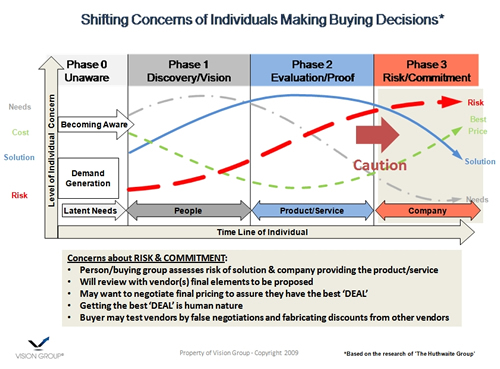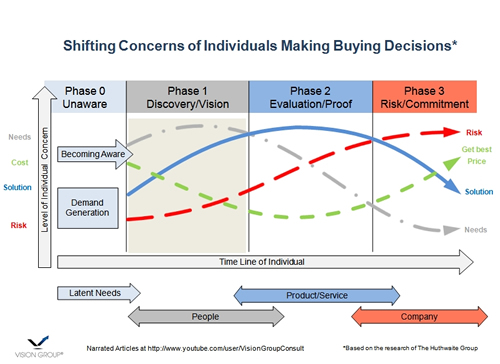Consultative Sales: Gain Trust of a Commitment with a Transition Plan - Part 3
“Understanding where the individual is in their buying process is critical in consultative based selling. A tool I use myself in the evaluation phase is a transition plan, an extension to the buying evaluation plan.” Here is part 3 of Dan Lemke’s story.
In part 2 I had finished meeting with the buying committee and my action item was to submit a Draft evaluation plan which was then finalized. After this we begin working the individual steps of the plan as we are moving jointly into phase 2 of the buying cycle, (see diagram).
Recall each step is a milestone moving the prospect toward making a yes or no decision. It is not a plan to buy my services. It is a plan to make a decision to buy, (or not to buy), various capabilities to satisfy their needs.
It is important to manage the buying evaluation plan. Which means to submit updates back to the buying committee in writing whenever a step is completed. Making sure to manage the go-no go decision points in the plan. These decision points were mutually identified when the plan was agreed upon and do not move forward with the project until a confirmative answer is received at each go-no go milestone.
Practicing what I preach, at each go-no go decision point, I make sure to get a yes or a no. Bad news early is good news. For both the seller and the buyer. Imagine how much time and resources can be wasted on a project if the actual answer to one of the go-no go decision points was no. Yet both the seller and the buying committee continue to work on the evaluation plan?
An important milestone in the evaluation plan is to develop a transition plan. Helping the customer move from where they are today, to a future state with the capabilities up and running in their business. This is more then just a startup plan. It includes any of the steps necessary for the prospect to have the new capabilities fully integrated into their business methods and processes. No small feat to accomplish with many products and services, which is why we utilize a formal transition plan.
NOTE: Here is a pdf version of the slides to Shifting Concerns of Individuals Making B2B Buying Decisions.
At this point let’s pick up where my story ended in the previous article, Gain Trust of the Committee for a Formal Evaluation.
Back to our story which we left off in part 2. As a reminder, the buying evaluation plan has been up and running for approximately 7 days. We are approaching the transition plan which was a single line item in the buying evaluation plan. All of the previous steps have been completed and I have documented the milestones back to the buying committee.
My next objective is to meet with the 3 people responsible to roll out the new sales training program across the division. As I did with the buying committee members, each person responsible to roll out new training programs is contacted by me to discuss their needs.
After each phone call, letters are written to document the transition needs, current situation, potential capabilities and value. They are each asked to share the information with the other members and a meeting is established. The meeting agenda looks very similar to the one used with the buying committee.
- Discuss the identified needs and the current situation
- Discuss potential capabilities offered and how they match up to the current needs
- Review the projected value they identified
- Review next steps
A few new needs and current situational items are discussed. The capabilities offered are sufficient to cover the existing and additional needs. We move on to the value, and nothing new comes up.
At this point it is acceptable to ask, what else would you need to know to get started with a transition.
After writing down their request, a sample transition plan is reviewed and we discuss any of the new items they did not bring up previously. Some of items are from my end and some are items which when not done in the past with other customers have led to difficult transitions.
My action item at the close of the meeting is to submit a Draft of the transition plan which is then worked together to arrive at a mutually agreeable plan. The transition plan approved by the 3 members is submitted to the buying committee in my next written correspondence progress update.
NOTE: We wrap the transition plan within the buying evaluation plan. By doing this, it becomes a natural progression of the buying evaluation plan and matches are ABC's, Always Be Closing, for the next step.

NOTE: Here is a pdf version of the slides to Shifting Concerns of Individuals Making B2B Buying Decisions.
With this customer, there is no hard negotiating at the end. The value was sufficient, all cost and services were known at the appropriate times and we moved into a natural transition to the training program.
This 3 part story is a real life situation. I did receive the order for the project and it turned out to be one of my largest customers. Hopefully you have enjoyed the story where I've tried to present the Vision Group methodologies of facilitating a buying committee through a buy-sell cycle from the discovery phase to the buying decision.
As stated, in this case, we did not negotiate. If you are interested in how I would have approached a win-win negotiation, here is an article.
Building Trust and The Best Buying Experience in B2B is a series of articles being written by the Vision Group.
- Discovering needs before we meet with the buying committee helps build a human connection - part 1.
- Helping create a Vision of a Solution moves the buying committee into the evaluation phase - part 2.
- Part of proof during the buying evaluation is a transition plan - part 3.

